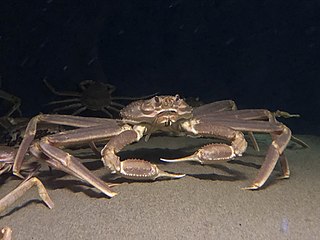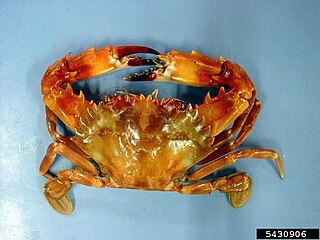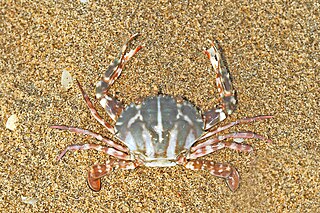
The velvet crab, also known as the velvet swimming crab, devil crab, fighter crab, or lady crab, is a species of crab from the North-East Atlantic and the Mediterranean. It is the largest of the swimming crab family (Portunidae) found in British coastal waters. It has a carapace width of up to 100 millimetres (3.9 in), and is the only species in the genus Necora. Its body is coated with short hairs, giving the animal a velvety texture, hence the common name. It is one of the major crab species for United Kingdom fisheries, in spite of its relatively small size.

Portunus pelagicus, also known as the blue crab, blue swimmer crab, blue manna crab and flower crab is a species of large crab found in the Indo-Pacific, including off the coasts Indonesia, Malaysia, Cambodia, Thailand, the Philippines, and Vietnam; and in the intertidal estuaries around most of Australia and east to New Caledonia.

Portunidae is a family of crabs which contains the swimming crabs. Its members include many well-known shoreline crabs, such as the blue crab and velvet crab. Two genera in the family are contrastingly named Scylla and Charybdis; the former contains the economically important species black crab and Scylla paramamosain.

Charybdis is a genus of swimming crabs in the family Portunidae. It is named after the monster Charybdis of Greek mythology.

Liocarcinus vernalis, the grey swimming crab, is a small, shallow-water crab in the family Portunidae. L. vernalis was thought for a long time to be a predominantly Mediterranean species, but its known range was extended by a series of observations in the 1980s and 1990s. It ranges from West Africa to the southern North Sea.

Ovalipes catharus, commonly known as the paddle crab, swimming crab, or Māori: pāpaka, is a species of crab in the family Ovalipidae. They are found in shallow, sandy-bottomed waters around the coasts of New Zealand, the Chatham Islands, and uncommonly in southern Australia. They are opportunistic, aggressive, and versatile feeders active mostly at night, preying predominantly on molluscs and crustaceans. They are also highly prone to cannibalism, which comprises over a quarter of their diet in some locations. Their paddle-shaped rear legs and streamlined carapace allow them to swim rapidly to capture prey and to burrow in the sand in order to escape predation. Their mating season is in winter and spring; the male carries the female until she moults, after which the two mate and the female likely moves into deeper waters to incubate and disperse her larvae.

Liocarcinus holsatus, sometimes known by the common name flying crab, is a species of swimming crab found chiefly in the North Sea, Irish Sea and English Channel. It has a carapace up to 4 centimetres (1.6 in) wide, which is brownish-grey with a green tinge. It is very similar in appearance to the harbour crab Liocarcinus depurator.

Charybdis japonica, the Asian paddle crab, is a species of swimming crab in the family Portunidae. Charybdis japonica has a hexagonal, concave carapace around 12 centimetres (4.7 in) wide, the whole animal being pale green to olive green in colour.

Chionoecetes opilio, a species of snow crab, also known as opilio crab or opies, is a predominantly epifaunal crustacean native to shelf depths in the northwest Atlantic Ocean and north Pacific Ocean. It is a well-known commercial species of Chionoecetes, often caught with traps or by trawling. Seven species are in the genus Chionoecetes, all of which bear the name "snow crab". C. opilio is related to C. bairdi, commonly known as the tanner crab, and other crab species found in the cold, northern oceans.

Around 65 species of crab occur in the waters of the British Isles. All are marine, with the exception of the introduced Chinese mitten crab, Eriocheir sinensis, which occurs in fresh and brackish water. They range in size from the deep-water species Paromola cuvieri, which can reach a claw span of 1.2 metres, to the pea crab, which is only 4 mm (0.16 in) wide and lives inside mussel shells.

Lissocarcinus orbicularis, common names sea cucumber crab, red-spotted white crab, and harlequin crab is a species of crab in the family Portunidae. This species gains one of its names from its close-knit relationship with holothuroids, the sea cucumbers. L. orbicularis should not be confused with L. laevis, a similar species of swimming crab, or Camposcia retusa, both of which are also commonly referred to as the harlequin crab. L. orbicularis displays numerous morphological and social adaptations for feeding and has a large distribution throughout the Indo-West Pacific.

Charybdis natator, the ridged swimming crab, wrinkled swimming crab or rock crab, is a widespread Indo-Pacific species of swimming crab from the genus Charybdis. It gets its name from the ridges on the dorsal surface of the carapace. It is a crab species which is of minor importance in fisheries.

Thalamita crenata, the mangrove swimming crab, crenate swimming crab or spiny rock crab, is a swimming crab species in the genus Thalamita. Distributed all over marine and brackish waters of Indo-West Pacific regions. It is widely used as an edible crab in many countries.

Charybdis hellerii, the Indo-Pacific swimming crab or spiny hands is a species of crab from the swimming crab family, the Portunidae. Its native range covers the Indian and Pacific Oceans but it has been introduced to the western Atlantic and has invaded the Mediterranean. It is a commercially exploited species in south-east Asia.
Charybdis longicollis, the lesser swimming crab, is a species of crab from the swimming crab family, the Portunidae. It has a native range which covers the north-western Indian Ocean and it has invaded the Mediterranean Sea by Lessepsian migration through the Suez Canal.
Jentina E. Leene was a Dutch scientist who had an early career in zoology, specifically carcinology, was a science teacher and then a textile scientist. Her zoological work was highly regarded, especially her doctoral thesis on the swimming crabs of the genus Charybdis.
William Stephenson MBE (1916–1996) was a British/Australian marine biologist and academic.

Charybdis feriata, the crucifix crab, is a species of swimming crab in the family Portunidae. It is found in the tropical and subtropical Indo-Pacific region.

Portunus segnis, the African blue swimming crab, is a species of crustacean, a swimming crab belonging to the family Portunidae. While native to the western Indian Ocean, it is also invasive in the Mediterranean. It is thought to have come through the Suez Canal from the Red Sea but it may have been transported by ships.

Scylla olivacea, commonly known as the orange mud crab, is a commercially important species of mangrove crab in the genus Scylla. It is one of several crabs known as the mud crab and is found in mangrove areas from Southeast Asia to Pakistan, and from Japan to northern Australia. Along with other species in the genus Scylla, it is widely farmed in aquaculture using wild-caught stocks. They can be differentiated from other species of Scylla by having blunted spines on the dorsal distal corner of the palm (propodus) of the claw, and by the rounded frontal lobe spines with shallow separations in between the eyes.


















